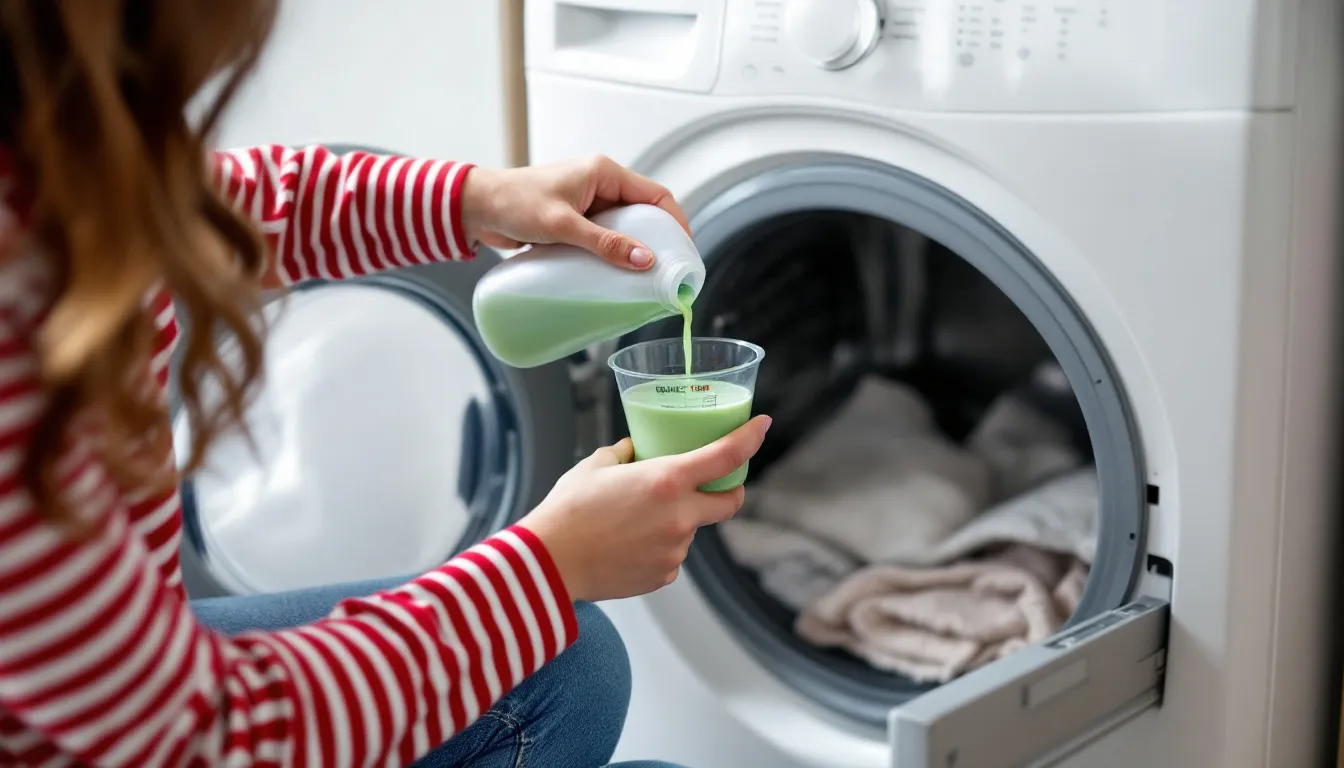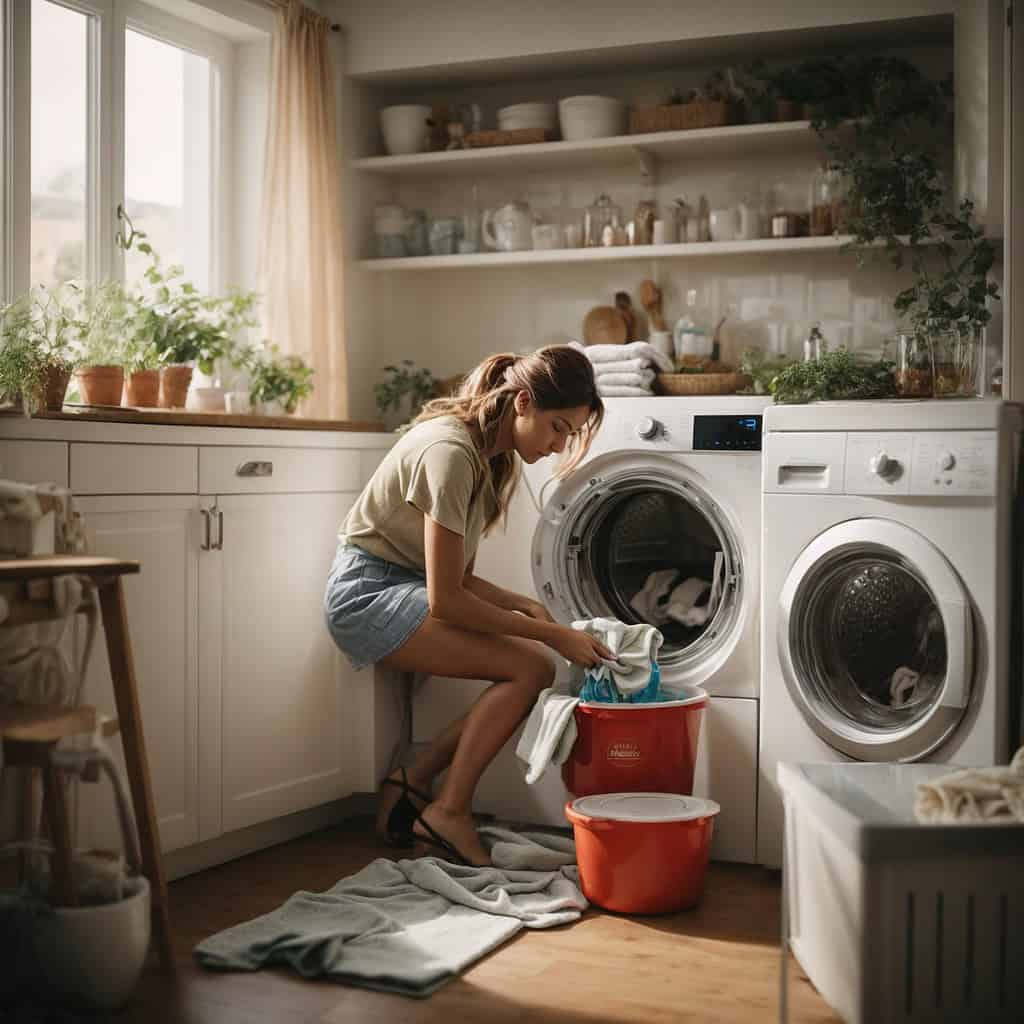
Ever wondered what to use to clean your washing machine effectively? Keeping your washing machine in top shape isn’t just about sparkling clothes; it’s about extending the life of your appliance and saving money on repairs.
Regular maintenance can enhance efficiency and prevent costly breakdowns. There are various options for what to use to clean washing machines, from natural remedies like vinegar and baking soda to commercial products designed specifically for this task. Each method offers unique benefits, ensuring your machine runs smoothly and your clothes come out fresh every time.
Let’s check out these washing machine cleaners and discover which one of them is the best fit for your needs.
Natural Cleaners
Using natural cleaners is a great way to go if you want to keep your washing machine in top shape. They’re not just good for cleaning, but they’re also eco-friendly. Two popular options are vinegar with baking soda and lemon juice mixed with salt.
Vinegar and Baking Soda
What You Need
To get started, gather the following items:
-
2 cups of white vinegar
-
1/4 cup of baking soda
-
A clean cloth or sponge
Step by Step Detailed Instructions
-
Empty the Machine: Ensure your washing machine is empty.
-
Add Vinegar: Pour 2 cups of white vinegar into the detergent dispenser.
-
Run a Hot Cycle: Set your machine to the hottest and longest cycle.
-
Add Baking Soda: Once the cycle starts, add 1/4 cup of baking soda directly into the drum.
-
Wipe Down: After the cycle, use a clean cloth to wipe down the drum and door seal.
Potential Challenges
You might notice a strong vinegar smell initially. Don’t worry; it dissipates quickly, leaving your machine fresh.
Pro Tips
-
Use this method monthly to keep your machine in top condition.
-
For stubborn stains, let the vinegar sit for an hour before starting the cycle.
Common Mistake to Avoid
Avoid using too much baking soda, as it can leave a residue if not rinsed properly.
Common Concerns
Some worry about vinegar damaging rubber seals. However, occasional use is generally safe and effective.
Lemon Juice and Salt
What You Need
Here’s what you’ll need for this method:
-
1 cup of lemon juice
-
1/4 cup of salt
-
A soft cloth
Step by Step Detailed Instructions
-
Prepare the Mixture: Mix 1 cup of lemon juice with 1/4 cup of salt.
-
Apply the Mixture: Use a soft cloth to apply the mixture to the drum and seals.
-
Run a Rinse Cycle: Set your machine to a rinse cycle to wash away the mixture.
-
Dry the Drum: After the cycle, dry the drum with a clean cloth.
Potential Challenges
Salt can be abrasive, so ensure it’s fully dissolved before applying.
Pro Tips
-
Lemon juice not only cleans but also leaves a pleasant scent.
-
Use this method every two months for optimal results.
Common Mistake to Avoid
Don’t use coarse salt, as it can scratch the drum.
Common Concerns
Some users worry about the acidity of lemon juice. Rest assured, it’s mild enough for occasional use.
Commercial Products
To keep your washing machine running smoothly, using store-bought cleaners is a really convenient and effective way to go. These products are specially formulated to deal with the dirt and residue that can pile up.
There are two popular options: Washing Machine Cleaner Tablets and Liquid Washing Machine Cleaners.
Washing Machine Cleaner Tablets
What You Need
To use washing machine cleaner tablets, you’ll need:
-
A pack of washing machine cleaner tablets (such as Affresh or Molly’s Suds)
-
Access to your washing machine’s cleaning cycle
Step by Step Detailed Instructions
-
Read the Instructions: Check the packaging for specific instructions.
-
Place the Tablet: Drop one tablet directly into the drum of your washing machine.
-
Select the Cleaning Cycle: Set your machine to the cleaning cycle or the hottest water setting.
-
Run the Cycle: Start the machine and let it complete the cycle.
Potential Challenges
Some users may find that tablets don’t dissolve completely in certain machines. If this happens, try breaking the tablet into smaller pieces before use.
Pro Tips
-
Use these tablets once a month to maintain optimal performance.
-
For heavily soiled machines, consider running two cycles back-to-back.
Mistake to Avoid
Avoid placing the tablet in the detergent drawer, as it may not dissolve properly.
Common Concerns
Some people worry about the environmental impact of these tablets. Look for brands like Molly’s Suds, which use eco-friendly ingredients.
What Else to Know
These tablets are designed to remove odor-causing residues and keep your machine running smoothly. They are a great option if you’re unsure what to use to clean washing machine effectively.
Liquid Washing Machine Cleaners
What You Need
For liquid washing machine cleaners, gather:
-
A bottle of liquid washing machine cleaner (such as Glisten)
-
A measuring cup, if needed
Step by Step Detailed Instructions
-
Measure the Cleaner: Pour the recommended amount of cleaner into the detergent dispenser.
-
Select the Cycle: Choose the hottest and longest cycle available.
-
Run the Machine: Start the cycle and let the cleaner work its magic.
Potential Challenges
Some machines may not have a dedicated cleaning cycle. In this case, use the hottest water setting available.
Pro Tips
-
Use liquid cleaners every three months for best results.
-
Consider alternating between tablets and liquid cleaners for comprehensive maintenance.
Mistake to Avoid
Don’t mix liquid cleaners with other cleaning agents, as this can cause unwanted chemical reactions.
Common Concerns
Some users worry about chemical residues. Rest assured, reputable brands like Glisten are formulated to rinse away cleanly.
Product Comparison Table
|
Product Name |
Type |
Key Ingredients |
Eco-Friendly |
Frequency of Use |
|---|---|---|---|---|
|
Affresh |
Tablet |
Sodium Carbonate, Citric Acid |
No |
Monthly |
|
Molly’s Suds |
Tablet |
Yes |
Monthly |
|
|
Glisten |
Liquid |
Citric Acid, Sodium Carbonate |
No |
Every 3 months |
DIY Solutions
Essential Oils and Vinegar
What You Need
To get started with this aromatic cleaning method, gather:
-
2 cups of white vinegar
-
10 drops of essential oil (such as tea tree or lavender)
-
A clean cloth or sponge
Step by Step Detailed Instructions
-
Prepare the Mixture: Mix 2 cups of white vinegar with 10 drops of your chosen essential oil.
-
Empty the Machine: Ensure your washing machine is empty.
-
Add the Mixture: Pour the vinegar and essential oil mixture into the detergent dispenser.
-
Run a Hot Cycle: Set your machine to the hottest and longest cycle.
-
Wipe Down: After the cycle, use a clean cloth to wipe down the drum and door seal.
Potential Challenges
You might find the scent of vinegar overpowering initially. However, the essential oils help mask it, leaving a pleasant aroma.
Pro Tips
-
Use this method every month to maintain freshness.
-
Choose essential oils with antibacterial properties for added benefits.
Mistake to Avoid
Avoid using too much essential oil, as it can leave a residue if not rinsed properly.
Common Concerns
Some worry about essential oils damaging rubber seals. Occasional use is generally safe and effective.
What Else to Know
Essential oils and vinegar not only clean but also deodorize your machine, making them a powerful duo for regular maintenance.
Hydrogen Peroxide and Baking Soda
What You Need
For this powerful cleaning combo, you’ll need:
-
1 cup of hydrogen peroxide
-
1/4 cup of baking soda
-
A soft cloth
Step by Step Detailed Instructions
-
Prepare the Mixture: Mix 1 cup of hydrogen peroxide with 1/4 cup of baking soda.
-
Apply the Mixture: Use a soft cloth to apply the mixture to the drum and seals.
-
Run a Rinse Cycle: Set your machine to a rinse cycle to wash away the mixture.
-
Dry the Drum: After the cycle, dry the drum with a clean cloth.
Potential Challenges
Baking soda can clump if not mixed well. Ensure it’s fully dissolved before applying.
Pro Tips
-
Hydrogen peroxide acts as a natural bleach, enhancing cleaning power.
-
Use this method every two months for optimal results.
Mistake to Avoid
Don’t use too much baking soda, as it can leave a residue if not rinsed properly.
Common Concerns
Some users worry about hydrogen peroxide’s bleaching effect. It’s mild enough for occasional use.
You’ve looked into a bunch of ways to keep your washing machine in good condition. Regular upkeep is super important for making it last and work well.
Choosing the right cleaner can help avoid turning little issues into big hassles. Whether you’re into natural fixes like vinegar and baking soda or prefer commercial cleaners like Affresh tablets, each has its own advantages.
Remember, a clean machine means fresh clothes and fewer repairs. So, pick the cleaning method that suits your lifestyle and keep your washing machine running smoothly for years to come.

Dave Johnson is a mechanical engineer with over two decades of experience in the semiconductor industry. He’s known for his exceptional ability to fix almost any mechanical and electronic device, from leaking faucets to lawnmowers – he is definitely your go-to neighbor for household maintenance issues. When he’s not elbow-deep in his garage doing household repairs, you’ll find him sharing his expertise on fixing everyday maintenance challenges on this site.


